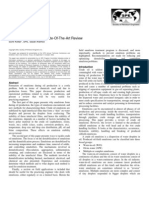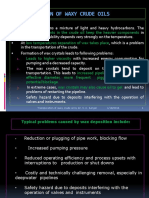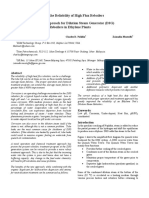Desalting Heavy Crude Oils - The Venezuelan Experience
Desalting Heavy Crude Oils - The Venezuelan Experience
Uploaded by
DomingoAPerazaSCopyright:
Available Formats
Desalting Heavy Crude Oils - The Venezuelan Experience
Desalting Heavy Crude Oils - The Venezuelan Experience
Uploaded by
DomingoAPerazaSCopyright
Available Formats
Share this document
Did you find this document useful?
Is this content inappropriate?
Copyright:
Available Formats
Desalting Heavy Crude Oils - The Venezuelan Experience
Desalting Heavy Crude Oils - The Venezuelan Experience
Uploaded by
DomingoAPerazaSCopyright:
Available Formats
Desalting Heavy Crude Oils The Venezuelan Experience
Kenneth W. Warren and John Armstrong
NATCO Group, Inc. 2950 N. Loop West #700 Houston, TX 77092
NATCO Group December 2001
Abstract: Dehydration of heavy crude oils presents unique challenges due to high viscosity, the presence of suspended solids and semi-soluble components, and the limited differential density for driving the sedimentation-based separation. Desalting these oils adds the complexities of mixing requirements that can produce stable dispersions and the use of fresh wash water that greatly reduces the available differential density. Venezuelan producers have recently begun exploitation of the very heavy crude oils of the Orinoco Tar Belt. This paper examines experiences in dehydration and desalting of these oils at four different sites incorporating sixteen units. Lessons learned regarding overall process requirements, suitable controls, desalter/dehydrator configurations, and operating conditions are discussed.
Introduction: Although exploitation of heavy oil deposits has been carried out for many years, the methods of production and processing of these crude oils generally limited their commercial development to shallow deposits in areas geologically favorable to thermally enhanced production methods. One of the largest deposits of heavy oil in the world lies in a belt north of the Orinoco River in Venezuela. (Figure 1) Estimates of original oil-in-place are in the range of 1.2 trillion barrels; however, only in recent years have methods been developed to render production of these deposits practical. The oil of the Orinoco Belt is extremely heavy with API gravities ranging from 4 to 9API, with a range of 7 to 9API in the zones presently being commercialized. Viscosities of the dead oil range from 20,000 to 100,000 cSt at ambient conditions. It is interesting to note that 10,000 cSt was once proposed as the dividing line between heavy oil and tar. Four projects are in various stages of development at present with others in conceptual development. All of them involve production and dilution of the heavy oil to a blend of approximately 17API with some treatment
(dehydration/desalting) at the field level followed by pipeline transportation to the Jose Petrochemical Complex. Each project entails individual up-grading facilities at the Jose Complex, where the blends are desalted and further dehydrated prior to the up-grading process. Present Production: A variety of processing schemes have been chosen for the current projects. Field facilities and the up-graders were handled as separate projects, often with different consultants, resulting in the selection of differing processing schemes in the upstream and downstream sides of the same project. Company A chose to use two trains of two-stage desalting at the field facility with further desalting at the up-grader. The dehydrator/desalters are Dual Polarity combination AC/DC electrostatic units. The desalters operate at 250 to 290F with heating by shell-and-tube heat exchangers upstream and firetubes in the desalters. De-gassing is accomplished in a three-phase separator operating at 90F and 2 psi. Design capacity is 158,000 BOPD. The up-grader associated with this project is not yet in operation. Company B chose to use four parallel single-stage dehydrators at the field facility with desalting in four parallel single-stage desalters at the up-grader. All of the dehydrators and desalters are Dual Polarity combination AC/DC electrostatic units operating at 290F. Heating is by plate-and-frame heat exchangers. De-gassing is accomplished in the field installation through a twophase separator operating at 140F and 150 psi. Design capacity is 170,000 BOPD. Both facilities are currently operating. Company C chose to use four parallel single-stage dehydrators at the field facility with desalting at the up-grader. The dehydrators are of Trivolt deep-field AC design operating at 284F. Heating is by a direct-fired heater. De-gassing is accomplished by a two-phase separator operating at 284F and 61 psi. Although not intended for desalting, there is provision for water injection prior to the dehydrators. Design capacity is 286,000 BOPD. The up-grader associated with this project is not yet in operation. Challenges Associated with Desalting Heavy Oils: Viscosity In order to achieve practical sedimentation rates, it is necessary to reduce the crude oil viscosity by operating at an elevated temperature. This in turn results in several adverse factors. Solubility of Water in the Crude Oil Water exhibits solubility in crude oil that increases with temperature. (Figure 2) As a rule-of-thumb, this solubility approaches 0.4% by volume at 150C. In a desalting process, the water that dissolves in the oil carries no salt with it; however, the loss of water from highly
saline drops may result in the precipitation of crystalline salt. The surface of the salt crystals acts as any other interface and tends to collect insoluble or semisoluble contaminants, which in turn make the crystal difficult to contact with the wash water. Injection of a portion of the wash water prior to heating can help alleviate this problem. A more difficult issue involves attainment of water-in-oil specifications. Process samples are collected through coolers that lower the temperature to prevent loss of volatile liquids. The cooling precipitates some of the soluble water, thereby increasing the reported water content of the oil. Since the desalter can only separate water that exists as a separate phase, this precipitated water represents an untreatable component under conditions existing within the process vessel. The interpretation of true separate phase water content under process conditions is further complicated by incomplete equilibrium in both the dissolution process and the precipitation reaction. Stress on the Electrical Insulators Desalters utilize insulators for support and electrical isolation of the electrodes and as glands for conducting the electrical power into the vessels. Fluorocarbons such as Teflon are the materials of choice for these insulators since they possess desirable mechanical and electrical properties and are resistant to fouling. However, fluorocarbons loose mechanical strength at elevated temperatures and tend to distort resulting in compromise of the sealing surfaces. The thermo-mechanical limitations of the insulators become the limiting conditions for operating temperature in a desalter. (Figure 3) Oil Conductivity Crude oil becomes more conductive with increased temperature. This conductivity increases the electrical power requirements necessitating larger power supplies and also limits the sustainable magnitude of the electrostatic field. (Figure 4) Limited Differential Density Separation within the desalter vessel is a Stokes Law based gravity separation of phases. As can be seen from inspection of Stokes equation, the rate of separation is dependent upon the drop size of the dispersed phase, the differential density of the phases, and the viscosity of the continuous phase. v= where 1.78 x10-6 (Dr ow )d 2 mo
v = Downward velocity of the water droplet relative to the oil, ft/sec, d = Diameter of the water droplet, m, Dr ow = Differential density between the oil and water, and m o = Dynamic viscosity of the oil, cp.
In field dehydration operations, the saline produced water is more readily settled than the fresh water encountered in desalting. Since heavy oils are close to the density of water, the driving force for separation is small. At elevated temperatures, this differential becomes even smaller. (Figure 5) Slow Disengagement of Associated Gas The movement of gas bubbles through these oils is impeded by the inherently high liquid viscosity and by the film strength at the gas-liquid interface. The presence of gas within the electrostatic coalescing zone retards the sedimentation process and seriously degrades performance. Conventional degassing techniques relying upon retention time are inadequate for assuring gas-free oil within the coalescer for these heavy crude oils. Effects of Solid Contaminants In addition to formation solids (sand and silt) and corrosion products, heavy oils often contain substantial quantities of semi-solid petroleum fractions that accumulate in desalter vessels. These solids-based sediments are found both in the bottom of vessels and in the water/oil interface zone where they contribute to stabilized or slowly resolving emulsion layers. Such layers constitute a hindered settling region in which sedimentation of water drops is adversely affected by the presence of other suspended phase materials. This interface sludge layer may exist in a steady-state equilibrium, in which case it may be considered part of normal operation. However, if it continues to increase in depth, steps must be taken to either resolve it or remove it from the desalter vessel. Removal is accomplished by interface sludge drains or by agitating the water layer sufficiently to mix the interface sludge into the water layer and remove it during mud washing. Sediments in the bottom of the vessel can become so deep that they interfere with flow distribution within the vessel. These sediments can be removed through a mud-wash or sand-jetting system. Chemical Treatment Chemical treatment of heavy oil systems usually requires a demulsifier to destabilize the incoming emulsion. Because natural emulsifiers are often present in large quantities, the dosage of chemical required for these systems may be much larger than needed for lighter crude oils. Suspended solids and semi-soluble hydrocarbon fractions are less amenable to chemical treatment and may render the chemical program marginally effective. Often, wetting agents prove useful for separating the suspended solids from the oil and forcing them into the water layer. Process Control Although there are many aspects to desalter process control mixing efficiency, separation efficiency, etc. one of the more difficult items to control in heavy oil installations is interface level control. The combination of small differences in density between the water and oil and the presence of interface sludge renders most displacement-type controls unsuitable. Successful
interface control under these circumstances depends upon the ability of the level probe to sense water content of a diffuse interface layer. Operating Results: The table below summarizes operating results from the previously mentioned companies as of this writing. Since these, like most heavy oil operations, experience variations in performance due to feedstock variations, position in maintenance cycles, and other influences, these results may or may not be indicative of long-term averages, but are offered as a performance snapshot valid at the time the data were taken. Company Diluted Bitumen Design Flow BPD Inlet BS&W % Outlet BS&W % Inlet Salt PTB Outlet Salt PTB Operating Temperature F Actual Flux BPD/ft2 Inlet BS&W % Outlet BS&W % Inlet Salt PTB Outlet Salt PTB Operating Temperature F Flux BPD/ft2 A 158,000 B 170,000 C 286,000 2.8 0.6 Not Measured Not Measured 248 60 Not Operational Not Operational Not Operational Not Operational Not Operational Not Operational
Upstream Operations 2.5 1.2 0.5 0.5 - 0.7 194 Not Measured 68 Not Measured 250/270 290 103 94 Downstream Operations Not Operational 0.8 + 8.0 Not Operational 0.7 Not Operational 25 Not Operational 2 Not Operational 290 Not Operational 64
Conclusions Application of Experience: The experience gained from these units in the dehydration and desalting of diluted bitumen yields several guidelines for similar applications. Viscosity is critical. The limiting sedimentation rate, and thus the size of the desalter vessel, is dependent upon viscosity. Temperature is the primary control for viscosity, and for heavy oils high temperatures, usually limited by the temperature tolerance of the insulators, are necessary. For diluted bitumen, diluent type and quantity also affect viscosity, but these factors are not primarily selected by viscosity concerns. Differential density is minimal. This is another factor in sedimentation rate and is controlled by type and quantity of diluent. Here a compromise between desalter size and diluent recycle cost must be reached.
5
Temperature also has an effect on differential density, but this is secondary to its contribution to viscosity control. Water solubility is substantial. The solubilization of water does not affect desalting performance unless it results in the formation of insoluble salts, but its precipitation upon cooling may affect the apparent dehydration efficiency of the system. True dehydration performance can only be evaluated by measuring total water content and subtracting the soluble component at operating conditions. However, because of incomplete approach to equilibrium, the exact quantity of soluble water is difficult to predict. Methods of performance measurement must be considered. Specifications for desalting systems normally state the allowable quantities of salt and water (or BS&W) in the treated oil. Occasionally, percentage removal is specified; however, it is much easier to achieve 99% salt removal when the inlet contains 500 PTB (pounds of salt per thousand barrels of oil) than when it contains 10 PTB. It is preferable to specify the allowable quantity of contaminants in the treated oil. Water content may be determined by ASTM D-95 (distillation), ASTM D-96 (field centrifugation), or ASTM D-4007 (laboratory centrifugation) depending upon the facilities available. The results of any of these tests should be interpreted in light of the potential contribution for untreatable soluble water. Salt may be determined by several methods also. For the salt quantities normally targeted for heavy oils, the conductivity method, ASTM D-3230, is satisfactory. For lower salt concentrations (1PTB or less), it is necessary to utilize a method using hot water extraction followed by salt determination of the extract, by titration or other methods. Solids must be controlled. Control involves both separation of the solids from the oil and prevention of their accumulation in the desalter vessel. Separation from the oil is accomplished by the use of chemical agents to render the solids hydrophilic and thus allow the wash water to carry them into the water layer. Alternatively, organic solids may be dispersed into the oil by chemical treatment. Solids that separate from the oil may end up on the bottom of the vessel or in the interface layer. Removal of bottom sediments requires the use of a mud-wash system consisting of water jets and drains. Interface sludge may be removed by sludge drains placed in the interface zone or by vigorous mud washing which stirs the interface sludge into the water layer. Sludge drains have the advantage of producing an lower volume of effluent which may then be treated by batch methods instead of contaminating the entire effluent water stream with refractory sludge. Operation of the mud-wash system should be done on a regularly scheduled basis as opposed to the interface sludge drains that are operated on an as-required basis. Interface control is difficult. By definition, heavy oils have small density differentials with water, and by nature, they tend to produce diffuse interface layers with very gradual density gradients. These factors render conventional interface controls displacers, weighted floats, etc.
unsuitable. Various conductance probes and capacitance probes have been utilized in these heavy oils, but it appears that the greatest degree of success has been with radio-frequency capacitance probes. Although these are considerably more expensive than conventional controls, their greater reliability makes them cost-effective in this service. Chemical treatment is necessary, but may be marginal. An ideal chemical treatment would produce a quickly separating dispersion with little or no interface layer. In heavy oils, this ideal is far from reality. An operator hopes to achieve a steady-state interface layer that can be maintained over an extended period of operation without excessive compromise of the electrostatic field. Perhaps it is fair to say that adequate chemical performance is the somewhat elusive goal. It is important that the chemical be well mixed with the oil and given adequate retention time in the oil before entering the desalter. Remember that the chemical, normally oil-soluble, must be given the time to diffuse through the oil to the drop surfaces and react with the natural emulsifiers there. The thick interface films present in heavy oils can make this a slow reaction. Mixing efficiency vs. dehydration requires a compromise. While this compromise is always present in desalting systems, nowhere is it more critical than in heavy oils. Increasing mixing valve differential pressure can quickly render the water-in-oil dispersion so fine that resolution within the desalter vessel is impossible. The large quantities of natural emulsifiers and suspended solids normally present in heavy oils greatly exacerbate this tendency toward stabilized dispersions.
Desalting of heavy oils is always a challenging operation. The difficulties presented require detailed consideration on the part of desalter designers and constant attention from plant operators. Heavy oil desalting processes are never set it and forget it operations. However, when approached with an understanding of the problems involved and vigilance toward operations, it has been demonstrated that these oils can be successfully treated.
Figure 1: Orinoco Belt Developments
Mesa 30 Blend
Naphtha Blend
0.35 0.30 0.25 0.20 0.15 0.10 0.05 0.00 50 100 150 200 250 300 Temperature F
Solubility vol%
Figure 2: Solubility of Water in 17API Blended Bitumen
550 Rated Load (lbs) 500 450 400 350 300 250 150 200 250 300 350 400
Temperature (F)
Figure 3: Design Load Curve for 2 Teflon Hangers
Conductivity pS/m
14000 12000 10000 8000 6000 4000 2000 50 70 90 Temperature F 110 130
Figure 4: Conductivity of Diluted Bitumen
17API Oil
Water
15API Oil
1.0 Density 0.9 0.8 0 100 200 300 400 Temperature F
Figure 5: Density Variation with Temperature
10
You might also like
- Alkylation Process Stratco PDFDocument14 pagesAlkylation Process Stratco PDFGeraldin Ching FrancoNo ratings yet
- High TAN CrudeDocument4 pagesHigh TAN CrudesenkuttuvanNo ratings yet
- Section Module1 - ExerSheetDocument3 pagesSection Module1 - ExerSheetArnel FelipeNo ratings yet
- Electrostatic Coalescer (Laminar Flow)Document3 pagesElectrostatic Coalescer (Laminar Flow)Yusof SundangNo ratings yet
- Crude Oil Emulsions A State-Of-The-Art ReviewDocument11 pagesCrude Oil Emulsions A State-Of-The-Art Reviewmalyari2002255100% (3)
- Emulsions (W&O and O&W) of Heavy Crude Oils - Characterization, Stabilization, Destabilization and Produced Water Quality, 2008Document88 pagesEmulsions (W&O and O&W) of Heavy Crude Oils - Characterization, Stabilization, Destabilization and Produced Water Quality, 2008joreli100% (1)
- Desalting HandbookDocument310 pagesDesalting HandbookFREDIELABRADORNo ratings yet
- 3 CDU W Pinch Analysis LiebmannDocument13 pages3 CDU W Pinch Analysis LiebmannAnsinath Barathi100% (1)
- Oil Ref Walk ThroughDocument7 pagesOil Ref Walk ThroughSumedh SinghNo ratings yet
- A Guideline To Calculate Erosional Velocity Due To Liquid Droplets For Oil and Gas IndustryDocument13 pagesA Guideline To Calculate Erosional Velocity Due To Liquid Droplets For Oil and Gas IndustryErika Caicedo100% (1)
- Transportation of Waxy Crude OilsDocument23 pagesTransportation of Waxy Crude OilsIshan Haider100% (2)
- Crude Overhead DesignDocument5 pagesCrude Overhead DesignDaniele CirinaNo ratings yet
- Simulation Reciprocating Compressor in HYSYSDocument4 pagesSimulation Reciprocating Compressor in HYSYSLenaldy Nuari GarnokoNo ratings yet
- Prediction of Viscosities of Petroleum Fractions, Yavuz Yorulmaz, 2009Document13 pagesPrediction of Viscosities of Petroleum Fractions, Yavuz Yorulmaz, 2009Anonymous Xy309m9Sm9No ratings yet
- Cenovus Oil RecoveryDocument41 pagesCenovus Oil Recoverysvnaik14No ratings yet
- Breaking Emulsion (PDF)Document7 pagesBreaking Emulsion (PDF)adamsamodraNo ratings yet
- Electro DesaltingDocument2 pagesElectro DesaltingMohamed Youssef100% (1)
- Crude Oil Properties and Condensate Properties and CorrelatiDocument20 pagesCrude Oil Properties and Condensate Properties and CorrelatiPablo Mendoza100% (1)
- Crude Oil RefiniringDocument96 pagesCrude Oil RefiniringNamwangala Rashid Natindu100% (1)
- 1 DesalterDocument20 pages1 Desalterbakhtyar21No ratings yet
- Heavy Oil's Production ProblemsDocument22 pagesHeavy Oil's Production Problemsalfredo moran100% (1)
- Natco Study On New Technology in DesaltersDocument31 pagesNatco Study On New Technology in Desaltersmohammad fallahNo ratings yet
- Crude Oil Distillation Rev41 PDFDocument142 pagesCrude Oil Distillation Rev41 PDFaalbuhseNo ratings yet
- Vacuum Residue PDFDocument17 pagesVacuum Residue PDFMarcos MaldonadoNo ratings yet
- Improve The Reliability of High Flux Reboilers PDFDocument7 pagesImprove The Reliability of High Flux Reboilers PDFAbhik BanerjeeNo ratings yet
- Calculate Viscosity of Crude OilDocument10 pagesCalculate Viscosity of Crude OilDominicNo ratings yet
- Multiphase BoostingDocument31 pagesMultiphase BoostingjoreliNo ratings yet
- Baker Hughes DesalterDocument5 pagesBaker Hughes DesalteralexHuy88No ratings yet
- SLB - SPE 165464 - Heavy Crude OilDocument15 pagesSLB - SPE 165464 - Heavy Crude OilblondtumbalaNo ratings yet
- Feature DebottleneckingDocument6 pagesFeature Debottleneckingsri9987No ratings yet
- Effect of Heavy Metals in Crude OilDocument6 pagesEffect of Heavy Metals in Crude OilDarl NwokomaNo ratings yet
- SPT Natco Electro Dynamic Desalter BrochureDocument2 pagesSPT Natco Electro Dynamic Desalter Brochuredani8887100% (1)
- Comparative Study of Normal and Acid Demulsifiers in Treating Aged Crude Oil EmulsionsDocument12 pagesComparative Study of Normal and Acid Demulsifiers in Treating Aged Crude Oil EmulsionsSinan KARADEMİRNo ratings yet
- Process Simulation of Crude Oil StabilizationDocument105 pagesProcess Simulation of Crude Oil Stabilizationafroznishat100% (5)
- CHE BP - Best Practices For The Control of Fuel Gas - May 2014Document4 pagesCHE BP - Best Practices For The Control of Fuel Gas - May 2014John UrdanetaNo ratings yet
- GPA08 PaperDocument9 pagesGPA08 PaperhicherkNo ratings yet
- Introduction of Petroleum & Crude OilDocument17 pagesIntroduction of Petroleum & Crude OilFaiz Ahmad100% (1)
- Chapter 4-Crude Oil DesaltingDocument19 pagesChapter 4-Crude Oil DesaltingYasir Khan100% (3)
- Shell-Hydrocracking Technology For Clean Fuels PDFDocument26 pagesShell-Hydrocracking Technology For Clean Fuels PDFAmelia FitriNo ratings yet
- Crude CharacterizationDocument43 pagesCrude CharacterizationHussein100% (1)
- Wartsila O GS Flare Gas Recovery SystemDocument2 pagesWartsila O GS Flare Gas Recovery SystemthaisonnguyenhoangNo ratings yet
- Petroleum StandardsDocument116 pagesPetroleum StandardsMark AnthonyNo ratings yet
- Ethylene Production PDFDocument28 pagesEthylene Production PDFMariam AsgharNo ratings yet
- All Crude Oil ProcessDocument7 pagesAll Crude Oil ProcessAli AlengineerNo ratings yet
- UOP Uniflex Heavy Oil Upgrading PaperDocument20 pagesUOP Uniflex Heavy Oil Upgrading PaperPae RangsanNo ratings yet
- Refinery PDFDocument22 pagesRefinery PDFromulussikalitNo ratings yet
- Hydrogen Production TechnologiesFrom EverandHydrogen Production TechnologiesMehmet SankirNo ratings yet
- Crude Petroleum analysis handbook: Crude oil Quality control, #1From EverandCrude Petroleum analysis handbook: Crude oil Quality control, #1Rating: 4 out of 5 stars4/5 (1)
- Natural Gas Processing from Midstream to DownstreamFrom EverandNatural Gas Processing from Midstream to DownstreamNimir O. ElbashirNo ratings yet
- Crude Oil TreatmentDocument27 pagesCrude Oil TreatmentmahmoudNo ratings yet
- High Volume Centrifugal Oil-Water Separation 00526746Document5 pagesHigh Volume Centrifugal Oil-Water Separation 00526746Hanif HalimNo ratings yet
- Crude Oil Desalting ProcessDocument18 pagesCrude Oil Desalting Processiancu_jianu_60% (1)
- Troubleshooting Guide For Crude Oil Dessalting SystemsDocument4 pagesTroubleshooting Guide For Crude Oil Dessalting SystemshichamNo ratings yet
- Analysis of Crude Oil Electrostatic Desalters PerformanceDocument5 pagesAnalysis of Crude Oil Electrostatic Desalters PerformanceAlvaro Andres Blanco GomezNo ratings yet
- Oil & Gas SeperationDocument34 pagesOil & Gas Seperationassatpute100% (2)
- Crude Oil Desalting ProcessDocument24 pagesCrude Oil Desalting ProcessamirejazNo ratings yet
- EmulsionsDocument14 pagesEmulsionsPaolo Cavaioni100% (1)
- Crude Treating & DesaltingDocument37 pagesCrude Treating & Desaltinggegio6080% (5)
- The Disposal of Ield Waste Water: Wright DaviesDocument7 pagesThe Disposal of Ield Waste Water: Wright DaviesDanivian HigginsNo ratings yet
- Oryzanol - e 2 0 PDFDocument21 pagesOryzanol - e 2 0 PDFJatinder Singh SodhiNo ratings yet
- 25PPWG ANNEX 7 IV Final ASEAN Guideline On Stability Study Drug Product R2Document42 pages25PPWG ANNEX 7 IV Final ASEAN Guideline On Stability Study Drug Product R2Hendra BayuNo ratings yet
- Abo Shosha Et Al 2008 Paraffin Wax Emulsion As Water Repellent For Cotton Polyester Blended FabricDocument11 pagesAbo Shosha Et Al 2008 Paraffin Wax Emulsion As Water Repellent For Cotton Polyester Blended Fabricسيدى غازى فلوج -No ratings yet
- Pharmaceutical ExcipientsDocument19 pagesPharmaceutical ExcipientsTikaUlamNo ratings yet
- Brochure LF Lubicants and Fuels Global enDocument5 pagesBrochure LF Lubicants and Fuels Global enJulian SerranoNo ratings yet
- Asfier N-480LDocument2 pagesAsfier N-480Lherry prasetyoNo ratings yet
- Ultrasound-Assisted Modification of Functional Properties and BiologicalDocument15 pagesUltrasound-Assisted Modification of Functional Properties and BiologicalFelipe Gomes da SilvaNo ratings yet
- RHEOLOGYDocument39 pagesRHEOLOGYraju niraula100% (1)
- Finding Science in Ice CreamDocument7 pagesFinding Science in Ice CreamsncNo ratings yet
- Konduktometri PDFDocument7 pagesKonduktometri PDFYuliaKamilawatiIINo ratings yet
- 1581 enDocument2 pages1581 enyasafyNo ratings yet
- Food Chem Past Exam Q - S 09-14Document11 pagesFood Chem Past Exam Q - S 09-14Ronald EnglishNo ratings yet
- Plant Pathology Fst3Document19 pagesPlant Pathology Fst3Alishba SherazNo ratings yet
- Colloids PDFDocument20 pagesColloids PDFye_ye2417No ratings yet
- AkzoNobel TB HlbEmulsionsDocument15 pagesAkzoNobel TB HlbEmulsionspajaron200No ratings yet
- Structured Biodegradable Polymeric Microparticles For Drug Delivery Produced Using Flow Focusing Glass Micro Uidic DevicesDocument12 pagesStructured Biodegradable Polymeric Microparticles For Drug Delivery Produced Using Flow Focusing Glass Micro Uidic Devices章昊No ratings yet
- Third Year B Pharmacy SyllabusDocument20 pagesThird Year B Pharmacy SyllabusSidhharrth S KumaarNo ratings yet
- OintmentsDocument47 pagesOintmentsIshitaVatsNo ratings yet
- CHEMPART PRO W21.es - enDocument1 pageCHEMPART PRO W21.es - enCanchindoNo ratings yet
- Lipids: Fats and Oils - Unit 4Document4 pagesLipids: Fats and Oils - Unit 4Kayon BrownNo ratings yet
- Exercise No. 24 - Turpentine Oil EmulsionDocument22 pagesExercise No. 24 - Turpentine Oil EmulsionAbby Dimalaluan OquendoNo ratings yet
- Pluronic PE Types: Technical InformationDocument12 pagesPluronic PE Types: Technical InformationMehul KhimaniNo ratings yet
- SANCHIDocument52 pagesSANCHIRahul ShrivastavaNo ratings yet
- TS 4000 Bitumen SurfacingDocument47 pagesTS 4000 Bitumen SurfacingShafiqullah GowharyNo ratings yet
- 2 Formation DamageDocument95 pages2 Formation DamageRaed fouadNo ratings yet
- SorbitanDocument4 pagesSorbitanSumatee Thanekumnao100% (1)
- Carbon Black - EncapsulationDocument10 pagesCarbon Black - EncapsulationWaltoy DinizNo ratings yet
- Effects of An Oxygenated Additive On The Emulsification Characteristics of Two - and Three-Phase Diesel EmulsionsDocument9 pagesEffects of An Oxygenated Additive On The Emulsification Characteristics of Two - and Three-Phase Diesel EmulsionsAbdoel Wahied ArohmanNo ratings yet
- 0901b8038005c60e PDFDocument12 pages0901b8038005c60e PDFfsfNo ratings yet

























































































